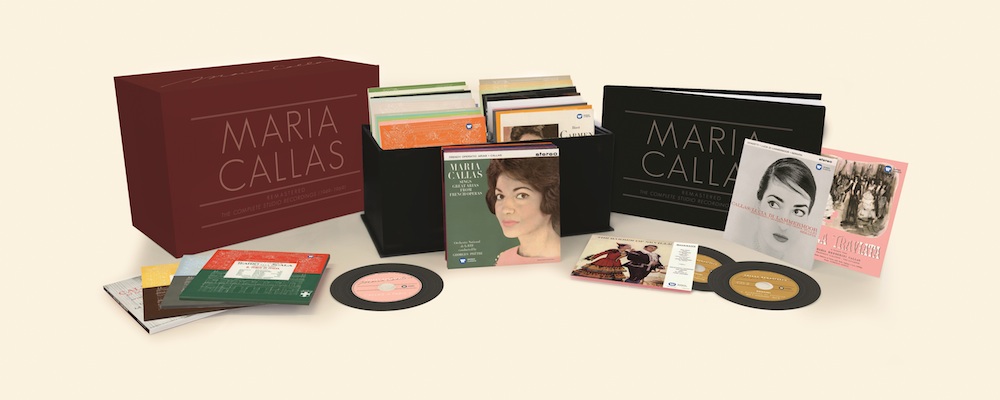
MARIA CALLAS REMASTERED
The Complete Studio Recordings (1949-1969)
The American-born, Greek soprano, Maria Callas (1923 – 1977), must hold a record for the sheer number of studio recordings made within a 20 year period: 26 complete operas and 13 recital discs in total. Apart from a few 78 rpms made at the beginning of her career for the CETRA label, all of Callas’ subsequent recordings were made by EMI. Together, these discs became the backbone of EMI’s rich vocal catalogue.
Given Callas’ iconic stature, her recordings were rarely, if ever, out of print: Excerpts were packaged, repackaged and packaged yet again: The Callas Effect; The Romantic Callas; The Passion of Maria Callas: The Very Best of Maria Callas; Maria Callas: Life and Art; Maria Callas: The One and Only; Maria Callas: the Legend; Maria Callas: the Voice of the Century; Maria Callas: The Platinum Collection; etc. The list is endless. And then, to mark the 20th anniversary of the diva’s death in 1977, EMI released an impressive, 69 CD box set which included all 39 of her studio recordings.
In 2013, however, EMI was sold to the Warner Music Group (for $765 million!). For this, Warner was given access to EMI’s vast catalogue of vocal recordings, but not to the EMI logo or brand itself. Given the importance, historically and musically, of the Callas oeuvre, Warner has issued a complete collection of Callas recordings, but this time under their own brand.
What makes this release unique from the EMI set is that Warner has gone back to the source: to the original production notes, editing logs and master tapes. Given the latest technological advances in digital editing and noise reduction software (such as RetouchTM and CEDARTM), Warner was able to repair or diminish many of the blemishes that populate the EMI set. As one of the engineers, Allan Ramsay, states in an accompanying book, “We just want to present the recording as it was meant to be heard – as they heard it in the control room, and as it was approved. We’re simply correcting faults just as the original producers would have done, had they had the technology…” This is also the first time the Callas tapes have been remastered at 96 kHz/24 bit – beyond CD quality (44.1 kHz/16 bits). One can hope that these will be made available for download in the not-too-distant future.
The Maria Callas edition – housed in an elegant, cerise and black box with white lettering – consists of 69 newly remastered studio recordings. Each disc is placed in a protective paper sleeve and then into a cardboard jacket featuring the original LP artwork. Libretti are available via a single CD-ROM. Also included is a hardcover, richly illustrated, 132 page book containing a biography of Callas, a chronology of her life, photographs, letters and logs, plus informative notes about the technological challenges in remastering this material. Each opera and recital is also available individually.
So that’s some of the background and history. Now, how does it all sound?
As there are 39 different projects involved (i.e., 26 operas and 13 recital discs), it is impossible to make too many generalisations, as each project has its own unique set of parameters that will have an impact upon the final results.
Each original master will have its own production team, recording venue, choice of microphones for recording, choice in microphone setup, choice of speakers for mixing, etc. Other factors will also come into play, such as the sophistication of your home stereo system and/or the level of ambient noise in your listening room. B & W speakers were used in Warner’s remastering. Although I use a smaller pair of B & W’s in my own system, they are more clinical than warm.
The most noticeable changes are perhaps in the early 78 rpm’s, where Warner’s remasterings reveal greater clarity, presence and definition on both Callas’ voice and on the orchestra. Surface noise, although not entirely eliminated, has been significantly reduced. Unfortunately one can do nothing to correct the wretched playing of the orchestra – the Orchestra Sinfonica di Torino della RAI under the baton of Arturo Basile.
In spot listening throughout the set, one can hear substantial, but subtle, changes. In comparing it to the EMI set, you can clearly hear where edits have been improved, clicks and pops removed, external noises (even “sneezes”) lessened, and problems with distortion resolved. As engineer Ramsay says, “All we want to do is remove the specks of dust, as it were, and wipe the glass clean. We’re presenting the recording in the best possible light, and as artists would have wanted it to be heard.”
In short, this Warner package is a monumental undertaking – a labour of love. It also has the words “Christmas Gift” emblazoned all over it. So start dropping hints to friends and family now. It’s sure to be a hot item.
The box set is available at Amazon.ca and iTunes.
- THE VOICE | Renée Fleming Turns Gold at Roy Thomson Hall - November 7, 2015
- THE SCOOP | Glenn Gould: Celebrating Genius with Cupcakes - September 28, 2015
- SCRUTINY | The Rebirth of R. Murray Schafer’s Apocalypsis - June 30, 2015




